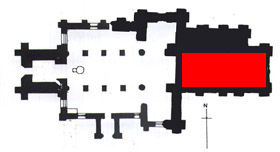St Mary's Bottesford Phase I, Romanesque
English transitional c1140-1280
By Bob Sparham
The section of St Mary’s which is the earliest is now called the chancel. The chancel together with its North and South aisles, was between the years 1140-1280 the complete church. The chancel was built in the style which is known as English transitional or Romanesque in the years immediately following the Norman Conquest under the patronage of the family of Robert de Todeni. Belvoir Castle was founded by Robert, who was William the Conqueror’s standard bearer. Robert also founded a small monastery near the Castle called Belvoir Priory and either he or his son William de Albini (who took his mothers surname) built a stone church in Bottesford. This church was probably on the site of a Saxon foundation because a church in Bottesford is recorded in the Doomsday Book.
However nothing now remains of the Saxon church and little now of the Norman, just a window high on the North Wall, some ‘dogtooth’ decoration round a doorway half way down the South Wall and the lower and middle courses of stonework which can be seen on the outside of the chancel and the old North aisle which is now the vestry.
Nonetheless this early phase was very important in the history of both the Church and Castle. Not least because one of the patrons of the Church, William of Albini III, great grandson of Robert de Todeni was one the barons who forced King John to sign the Magna Carta in the meadows of Runnymede thus laying the foundations of British liberties. William’s second son Nicholas is the first recorded Rector of Bottesford. Nicholas the priest was forced to surrender Belvoir Castle to King John after the King took his revenge by firstly by having William ex-communicated by Pope Innocent III and secondly by defeating him and the other barons at the siege of Rochester Castle. William of Albini III was held hostage by King John as indeed was Nicholas who was a hostage of King John’s son Henry III. Later, however William achieved favour with the King and regained his lands and castle. William’s granddaughter Isabel became the sole heiress of the family and in 1257 she married Robert de Roos, Baron of Hamlake who thus became the Lord of Belvoir Castle.
Decorated










No Comments
Add a comment about this page